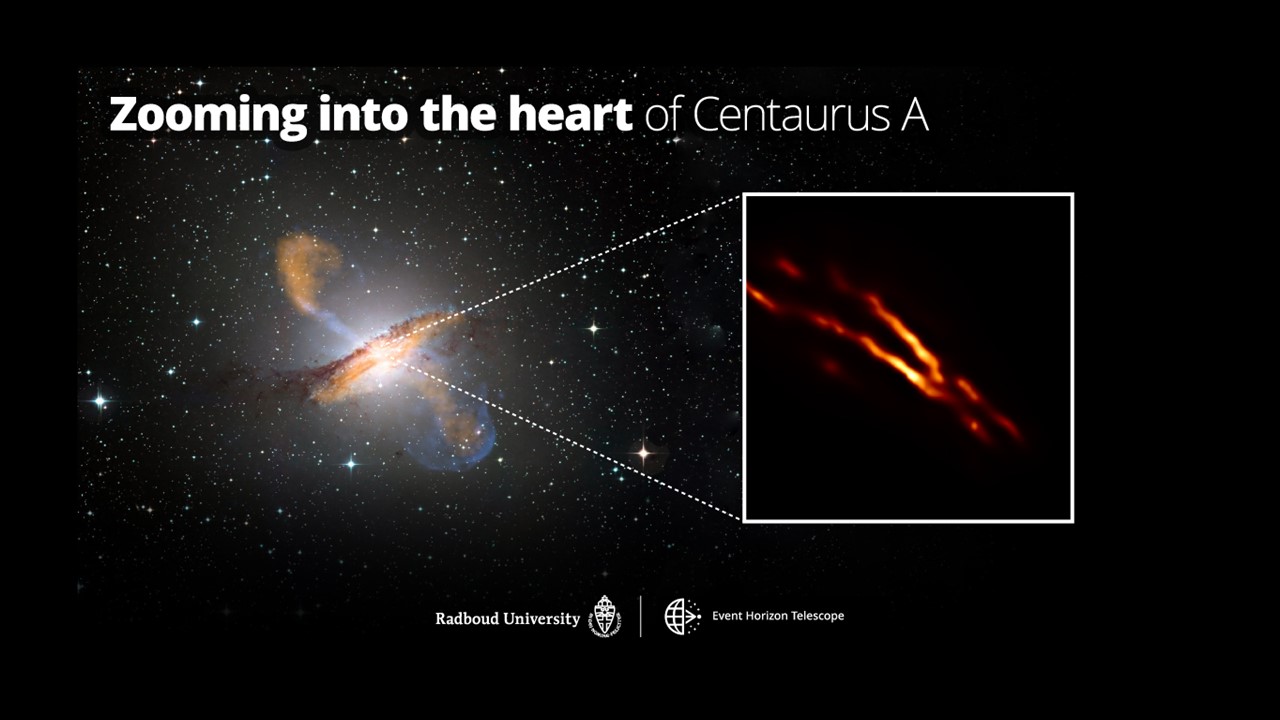On April 10th, 2019, the world was treated to the first image of a black hole, courtesy of the Event Horizon Telescope (EHT). Specifically, the image was of the Supermassive Black Hole (SMBH) at the center of the supergiant elliptical galaxy known as M87 (aka. Virgo A). These powerful forces of nature are found at the centers of most massive galaxies, which include the Milky Way (where the SMBH known as Sagittarius A* is located).
Using a technique known as Very-Long-Baseline Interferometry (VLBI), this image signaled the birth of a new era for astronomers, where they can finally conduct detailed studies of these powerful forces of nature. Thanks to research performed by the EHT Collaboration team during a six-hour observation period in 2017, astronomers are now being treated to images of the core region of Centaurus A and the radio jet emanating from it.
The study that describes their findings, which recently appeared in Nature Astronomy, was performed by the EHT Collaboration, which involves more than 300 researchers from Africa, Asia, Europe, North and South America. They were joined by researchers from the Max Planck Institute for Radio Astronomy, the Black Hole Initiative (BHI), the Yale Center for Astronomy and Astrophysics, the Princeton Center for Theoretical Science, the Flatiron Institute, and multiple universities and research institutes.

For decades, astronomers have known that SMBHs reside at the heart of most massive galaxies surrounded by massive rings of dust and gas. These rings are caused by the SMBHs tremendous gravitational pull, which accelerates the dust and gas to relativistic speeds (a fraction of the speed of light) and triggers the release of massive amounts of electromagnetic energy (including radio waves).
This process is what leads to galactic nuclei becoming “active” – aka. an Active Galactic Nucleus (AGN) or quasar – where the core region vastly outshines the galactic disc many times over. Whereas matter on the edge of the black hole is accreted onto its face, some of the surrounding matter escapes into space moments before it is captured in the form of relativistic jets – one of the most energetic features in the known Universe.
As they indicate in their study, the data obtained from the 2017 EHT observation campaign allowed the team to capture images that were ten times higher in terms of frequency and sixteen times sharper in resolution. This was made possible by the EHTs resolving power, which is the result of eight radio observatories that – when combined – make up a virtual telescope with an aperture the size of Earth.
Located over 13 million light-years from the Milky Way, Centaurus A is the closest radio galaxy to our own and (when imaged in radio wavelengths) is one of the largest and brightest objects in the night sky. Using the same interferometry technique that allowed for images of M87 to be taken, the team to observe Centaurus A with incredibly sharp resolution at a wavelength of 1.3 mm.

As study co-author Heino Falcke, an EHT board member and professor for Astrophysics at Radboud University, said in a NOVA press release:
“This allows us for the first time to see and study an extragalactic radio jet on scales smaller than the distance light travels in one day. We see up close and personally how a monstrously gigantic jet launched by a supermassive black hole is being born…
“These data are from the same observing campaign that delivered the famous image of the black hole in M87. The new results show that the EHT provides a treasure trove of data on the rich variety of black holes and there is still more to come.”
Previously, the task of monitoring Centaurus A at radio wavelengths was overseen by Tracking Active Galactic Nuclei with Austral Milliarcsecond Interferometry (TANAMI), a multiwavelength program that consists of nine radio telescopes located on four continents. Since the mid-2000s, TANAMI has been studying the core region of Centaurus A with VLBI at centimeter wavelengths, as well as other relativistic jets and Active Galactic Nuclei (AGN) in the Southern Sky.
However, the new image was not only much higher in terms of resolution, but it also revealed features of Centaurus A that were never before seen. For example, the EHT team noticed that Centaurus A is brighter at the edges compared to the center, a phenomenon that has been observed with other jets but never as pronounced. These observations will inform astrophysicists’ attempts to model how matter behaves in the presence of SMBHs, which is still unclear.
In particular, astrophysicists are still trying to figure out exactly how relativistic jets are launched or how they can extend for light-years without dispersal. “We found it challenging to explain with the same models we used for M87,” Said Sera Markoff, the Vice-Chair of the EHT Science Council and a co-author on the study. “Something different must be happening, like helical magnetic fields, which gives us new clues about how they may ‘squeeze’ the jets.”
Thanks to the new EHT observations of the Centaurus A jet, it is believed that the launching point of the jets conforms to the likely location of the SMBH. Based on this, the research team predicts that future observations at even shorter wavelengths and resolutions would be able to photograph the SMBH at the center of Centaurus A – similar to what was done in 2019 with M87.
This will likely require space-based observations, which will allow for more precise baseline interferometry (being free of atmospheric distortion). The ongoing study of this phenomena, made possible thanks to arrays like the EHT, is also letting astronomers observe how the laws of physics work in the most extreme environments in the Universe.

